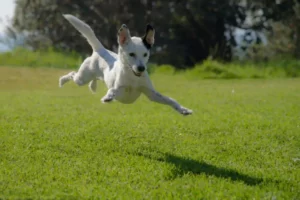What is considered good exercise for a dog?
Dogs are known for their high energy levels and need for physical activity. Regular exercise is crucial to maintaining good health, both physically and mentally. But what exactly is considered good exercise for a dog?
Walking the dog is probably the most common form of exercise that dogs receive. It’s a great way to keep them active and healthy, while also providing an opportunity for bonding time between you and your furry friend.
But not all walks are created equal. The amount of exercise a dog needs can vary depending on their breed, size, age, and overall health.
For example, some breeds like French Bulldogs or Terriers are high-energy dogs that require more exercise than other breeds like Golden Retrievers or German Shepherds. A French Bulldog might be content with a daily 30-minute walk around the block, while a German Shepard might need an hour-long walk twice per day or even more intense activities such as running or playing fetch.

But regardless of breed type, it’s important to pay close attention to your individual dog’s reaction to exercise. Dogs should never be pushed beyond their limits as this can lead to injuries such as sprains or even exhaustion.
Moreover, good exercise doesn’t have to always involve physical activity outside as some indoor activities can also provide significant benefits such as mental stimulation especially during bad weather conditions when taking dogs outside is not possible or safe. Walking the dog remains one of the best exercises available for pets regardless of its breed type but It’s important to tailor each session according to your pet’s needs and capabilities rather than blindly adhering to pre-existing regimes designed around general assumptions about certain breeds.
How many miles should a dog walk a day?
Knowing how much exercise a dog needs can be a bit tricky, as it depends on factors such as the dog’s breed, age, and overall health. However, a general rule of thumb is that dogs should get at least 30 minutes to two hours of exercise per day. This can include walking, running, playing fetch or other games, and even swimming.
The amount of miles a dog should walk each day will also vary based on these factors. For example, a high-energy breed like a German Shepherd may need more than two hours of exercise per day and could benefit from walks that are several miles long.
On the other hand, a small French Bulldog may only need 30 minutes to an hour of exercise per day and may be content with shorter walks around the block. Golden Retrievers are known for their playful nature and love for being outdoors.
They require at least an hour or two of daily physical activity to maintain their health and happiness. In fact, walking the dog twice daily can greatly improve their mental health and keep them from getting bored or destructive.
It’s important to note that while some dogs may enjoy long walks or runs, others may have physical limitations that prevent them from going too far. Older dogs or those with certain health conditions like arthritis may need shorter walks or low-impact activities like swimming instead.
Ultimately, the amount of exercise your dog needs will depend on their individual needs and preferences. It’s important to work with your veterinarian to develop an exercise routine that is safe and appropriate for your furry friend so they can stay healthy and happy for years to come!
Which breeds need the most exercise?
When it comes to the amount of exercise needed by different dog breeds, there is no one-size-fits-all answer.
Some dogs are naturally energetic and require a lot of physical activity, while others are more laid-back and don’t need as much exercise. However, there are certain breeds that generally require more exercise than others.
Terrier breeds, such as Jack Russell Terriers and Rat Terriers, are known for their high energy levels and love for physical activity. They were originally bred to hunt small game and vermin, so they have a lot of energy to burn.
These dogs typically require at least an hour of daily exercise to keep them happy and healthy. Frenchies or French Bulldogs are a popular breed among city dwellers due to their small size and affectionate nature.
However, despite their compact size, they still require daily exercise. Frenchies tend to have breathing problems due to their short snouts but regular walks can greatly help with this issue.
German Shepherds are another breed that needs a lot of exercise due to their high energy levels and working background as police or military dogs. They thrive on being given tasks such as obedience training or agility courses in addition long walks or runs.
Golden Retrievers were originally bred for hunting purposes but have become popular family pets due to their friendly nature. They too need plenty of regular exercises with long walks being an ideal way for them to expend some of their abundant energy.
It’s important to note that even within these breeds there can be variations in individual energy levels based on age and temperament. It’s always best to consult with a veterinarian or professional trainer about your specific dog’s needs when it comes finding the right amount of exercise for them.
What dogs don’t like exercise?
Many dog owners may find that their furry friend simply doesn’t enjoy exercise. While some breeds are highly energetic, others tend to be more laidback and less interested in physical activity. However, it’s important for all dogs to get some form of exercise in order to maintain a healthy weight and prevent health problems down the road.
One breed that tends to be less enthusiastic about exercise is the French bulldog. These adorable pups are known for their affectionate personalities and love of snuggling up with their owners.
However, they don’t require a lot of physical activity to stay healthy and happy. Short walks or play sessions indoors can be enough to keep them satisfied.

Another breed that may not enjoy exercise as much as others is the golden retriever. While these dogs are known for their love of fetching and swimming, they can also become bored with repetitive activities over time.
It’s important for owners to switch things up and provide mental stimulation as well as physical activity. Terriers are another group of dogs that may not always enjoy traditional forms of exercise such as walking or running.
These small but mighty pups have high energy levels but can also become easily distracted by sights and smells in their environment. It’s important for owners to find ways to engage them mentally while also providing opportunities for physical exertion.
German Shepherds may not enjoy long periods of walking or running if they have not received proper training or socialization. These protective dogs thrive on structure and routine, so it’s important for owners to establish clear boundaries when engaging in physical activity with them.
While certain breeds may be less inclined towards traditional forms of exercise such as walking the dog or running alongside their owner, all dogs require some level of physical activity in order to maintain good health. By finding activities that align with your dog’s preferences and personality, you can ensure that they stay happy and healthy throughout their life.
Is it OK not to walk your dog everyday?
Walking the dog is a daily activity that has become a staple for most pet owners. However, as much as we prioritize this activity, sometimes we may not be able to walk our dogs every day.
While this can be concerning for some, it is generally okay if you are still providing your dog with enough exercise and mental stimulation. Firstly, it is important to understand that different breeds have different exercise requirements.
For example, terriers and Frenchies are small breeds that do not require long walks but still need regular playtime and mental stimulation. On the other hand, Golden Retrievers and German Shepards are high energy breeds that require a lot of physical exercise daily.
Therefore, whether or not it’s ok not to walk your dog every day largely depends on their breed. Secondly, there is no one-size-fits-all answer when it comes to how much exercise your dog needs.
It depends on their age, breed, health condition and personality traits. In general, most dogs need at least 30 minutes of physical activity per day in addition to regular playtime with their owners or toys.
If you can’t manage a full walk every day due to time constraints or other factors such as weather conditions or health issues; consider breaking up the exercise into shorter sessions throughout the day. Thirdly, if you are unable to walk your dog regularly due to medical conditions such as arthritis or any other injury that makes walking difficult then consider alternative methods of exercising them such as swimming or playing fetch in an enclosed area like a backyard or park.

Yet importantly; remember that walking isn’t the only form of exercise for your pet; interactive toys like puzzle feeders help keep their minds engaged while also being physically active especially for breeds like French Bulldog which may get bored easily. : While walking is an essential part of keeping your furry friend healthy and happy; missing a day or two of walking is usually not a cause for alarm.
If you’re unable to walk your dog, there are plenty of other ways to keep them active and engaged. Ultimately, the most important thing is to ensure they get enough exercise and mental stimulation to keep them physically and mentally healthy.
Conclusion
The best type of exercise for your dog will depend on several factors, including breed, age, and overall health.
It’s essential to make sure your dog is getting enough physical activity to maintain their physical and mental well-being. Walking the dog is an excellent way to get them moving, but it’s not the only option.
If you have a Frenchie or a Bulldog, keep in mind that they aren’t known for their athleticism. Short walks and indoor playtime might be enough to meet their needs.
On the other hand, German Shepards and Terriers require more exercise to stay healthy and happy. Remember that puppies need less exercise than adult dogs because their bones are still developing.
It’s essential to start slow with any new exercise routine and gradually increase intensity over time. It’s crucial to pay attention to your dog’s body language while exercising.
If they’re showing signs of exhaustion or discomfort, stop immediately and give them a break. With consistent effort, you can find the perfect exercise routine for your furry friend that will benefit them both physically and mentally.
Owning a dog comes with great responsibility in ensuring they get regular physical activity that suits their needs as well as being aware of any limitations or warning signs during exercises such as walking or playing fetch with your Golden Retriever. By doing so, you can promote healthy habits in both yourself and your four-legged companion while enjoying all the benefits of an active lifestyle together!
